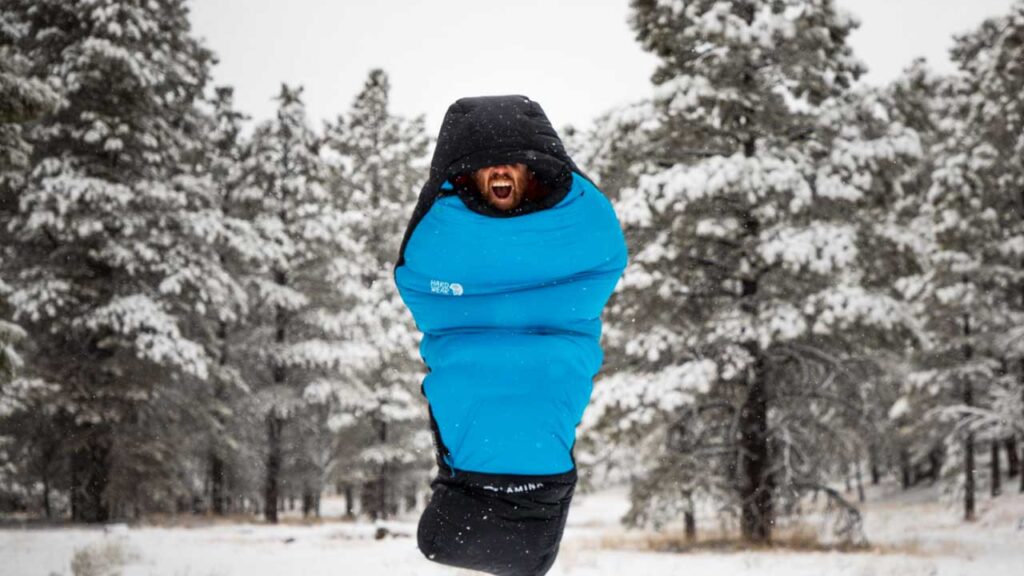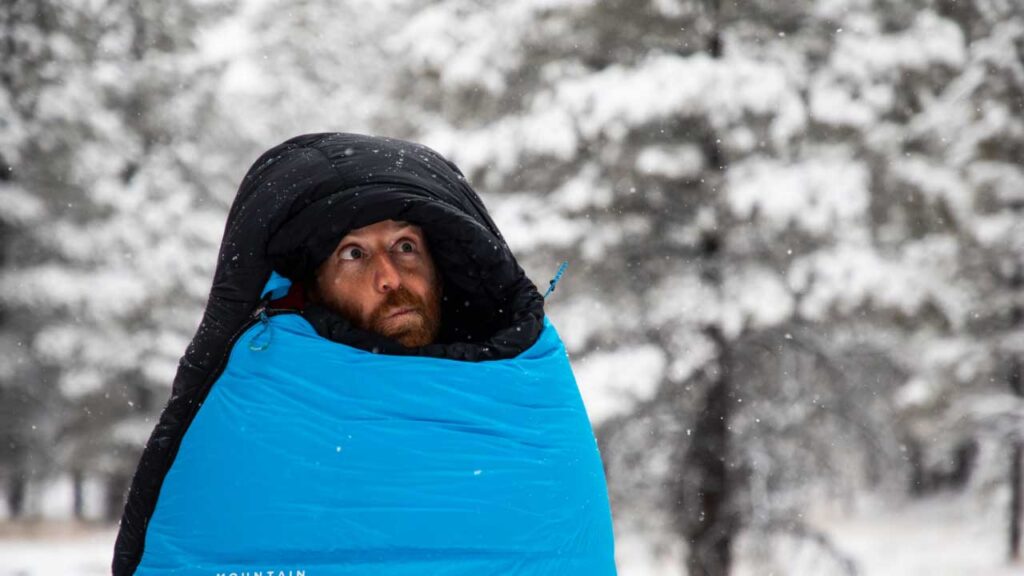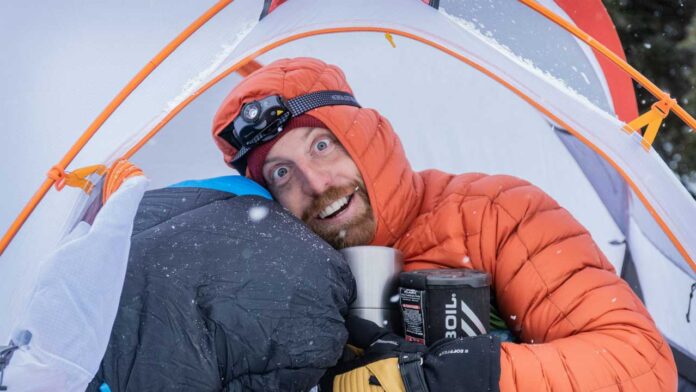Now that summer is thoroughly in the rear-view mirror, and the inviting fall colors are giving way to harsher conditions (depending on where you are), I thought it would be a good time to talk about some basics of camping in winter or during a snowstorm. The backpacking fun doesn't have to stop just because there is a snowstorm with a foot of snow!
I'm a big believer in the saying that there is no bad weather (within reason), only bad gear. If you have adequate protection, and know what you're doing, then winter camping can be a cozy and unique outdoor experience. Now, staying warm while moving around is one thing, but the thought of those bone-chilling nights can be intimidating. Fear not! I have a few tricks of the trade that will keep you warm and well-rested – not just surviving, but actually having a good time.
What type of sleeping bag is best for cold weather?

There is a big difference between a cool-weather (say 15-degrees Fahrenheit) sleeping bag that you may have poached from the attic, and investing in a full-blown, heavy-duty winter one.
For instance, one of my dependable go-tos has been a -20-degree bag from Marmot – complete with a cinchable hood to trap that precious body heat. I've used this to sleep soundly through multiple blizzards.
If you pay attention to the bag's posted temperature ratings (more on this in a second), and match this with the expected conditions for your adventure (with a buffer built in for safety reasons), you can totally have the same positive experiences.
How do I choose a winter sleeping bag?
Just because a sleeping bag is rated for a certain temperature, doesn’t mean that you will be comfortable if the thermometer drops to exactly that number. The rating you’re looking at may simply mean that the bag can handle that type of weather and get you through to sun-up.
Some companies use the EN Rating System, which will tell you the comfort range, as well as the core (or risk) range. This will help you make an informed choice about what bag will be best for the conditions you expect to encounter. Making sure you’re comfortable (and not just clinically alive) will significantly improve your quality of sleep, and therefore, the quality of your outdoor adventure.
How do you sleep in a tent during a snowstorm?

Having a sleeping bag that is sufficiently rated for sub-zero temperatures is the first step, but following that up with an adequate sleeping pad/mattress is just as important. Whether you're hunkering down in the snowstorm, or during winter months, what separates your body from the ground is going to be the difference maker.
I've had a lot of success with Sea to Summit's Comfort Plus Insulated Air Sleeping Mat. It's a 4-season pad that has two air chambers – one to absorb the cold air coming off the ground, and another to conserve the warmth coming off your body. So don't let the ground sap your energy during the night – get yourself a solid sleeping pad.
Why are my feet always cold in a sleeping bag?
Now that your sleeping bag and mattress are appropriately rated for the weather, the next big mistake I see winter campers making is letting their feet hang freely out the back. Extremities are the first body parts to get cold in the night, and this is only exacerbated if they are making contact with the ground. So for starters, make sure that your sleeping pad is long enough for you, not just in theory, but when you get the pillow on there and plunk down in your usual fashion.
If the dimensions still don't line up, then the other option is to use your spare clothes/stuff sacs to make a little buffer. Shorter campers can also use this strategy inside their sleeping bag. If there's dead space at the end of your bag then your feet are going to pay the price (even if they're properly elevated). One of my favorite hacks is to chuck a hot water bottle (or even a Nalgene filled with warm water) down there.
Is a sleeping bag with a hood better?

When it comes to cold-weather camping, a sleeping bag with a hood is essential. Without it, so much body heat is going to escape from your head and shoulders, and likewise, that crisp air is going to tease those areas all night. Cinch it up as much as you can without covering your mouth or nose. This will make it easier to breathe (obviously), but will also prevent the moisture that you exhale from building up inside. Being damp is not a good combo for deep sleep!
What is a draft collar on a sleeping bag?
A draft collar is an inner layer of fabric that also keeps the warm air inside the sleeping bag from escaping as you shift around throughout the night. A good winter bag should have one of these. Just like the hood, make sure to cinch it up after crawling in so that your body doesn't have to continuously work to keep you comfortable.
Snowstorm Camping Tip #1:
I know it's hard to willingly drag yourself out of a cozy sleeping bag on a cold night, but if you have to pee, heed the call! Don't kid yourself into thinking the urge will subside on its own. Especially on a cold night, when you've probably been drinking lots of hot liquids around the campfire, it's only going to get progressively worse. Just bite the bullet and empty your bladder. You'll sleep much better afterwards.
Snowstorm Camping #2:
Winter camping is greatly enhanced by having a cuddle buddy. Both Kristi and Kovu have kept me warm through some pretty desolate nights. So don't be shy about cozying up during those chilly adventures.
If you've been hesitant about extending your trips into the so-called “off-season,” then I hope these suggestions encourage you to give it a shot. Winter camping can be a beautiful experience, and you don't have to suffer through the nights to make it happen. Pack appropriately, and utilize your gear to its full potential, and you'll find you sleep surprisingly well. For more year-round tips, gear reviews, and travel/trail adventures, subscribe to In4Adventure newsletters.





